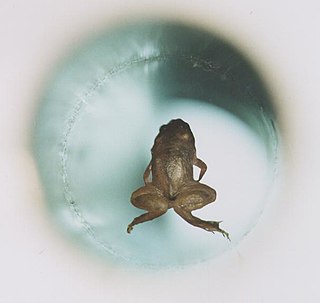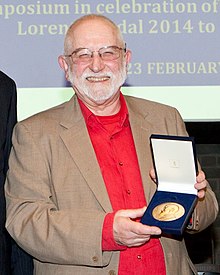
The Ig Nobel Prize is a satiric prize awarded annually since 1991 to celebrate ten unusual or trivial achievements in scientific research. Its aim is to "honor achievements that first make people laugh, and then make them think." The name of the award is a pun on the Nobel Prize, which it parodies, and on the word ignoble.

Sir John Anthony Pople was a British theoretical chemist who was awarded the Nobel Prize in Chemistry with Walter Kohn in 1998 for his development of computational methods in quantum chemistry.

Antony Hewish was a British radio astronomer who won the Nobel Prize for Physics in 1974 for his role in the discovery of pulsars. He was also awarded the Eddington Medal of the Royal Astronomical Society in 1969.

Sir William Lawrence Bragg, was an Australian-born British physicist and X-ray crystallographer, discoverer (1912) of Bragg's law of X-ray diffraction, which is basic for the determination of crystal structure. He was joint recipient of the Nobel Prize in Physics in 1915, "For their services in the analysis of crystal structure by means of X-rays"; an important step in the development of X-ray crystallography.

Sir Peter Mansfield was an English physicist who was awarded the 2003 Nobel Prize in Physiology or Medicine, shared with Paul Lauterbur, for discoveries concerning Magnetic Resonance Imaging (MRI). Mansfield was a professor at the University of Nottingham.

Fellowship of the Royal Society is an award granted by the Fellows of the Royal Society of London to individuals who have made a "substantial contribution to the improvement of natural knowledge, including mathematics, engineering science, and medical science".

Robert McCredie May, Baron May of Oxford, HonFAIB was an Australian scientist who was Chief Scientific Adviser to the UK Government, President of the Royal Society, and a professor at the University of Sydney and Princeton University. He held joint professorships at the University of Oxford and Imperial College London. He was also a crossbench member of the House of Lords from 2001 until his retirement in 2017.

Sir George Paget Thomson, FRS was a British physicist and Nobel laureate in physics recognized for his discovery of the wave properties of the electron by electron diffraction.
Sir Edgar William John Mitchell, was a British physicist, professor of physics at Reading and Oxford, and he helped pioneer the field of neutron scattering.

Sir David James Wallace, CBE, FRS, FRSE, FREng is a British physicist and academic. He was the Vice-Chancellor of Loughborough University from 1994 to 2005, and the Master of Churchill College, Cambridge from 2006 to 2014.

Yakir Aharonov is an Israeli physicist specializing in quantum physics. He has been a Professor of Theoretical Physics and the James J. Farley Professor of Natural Philosophy at Chapman University in California since 2008. He was a distinguished professor in the Perimeter Institute between 2009-2012 and is a professor emeritus at Tel Aviv University and at University of South Carolina. He is president of the IYAR, The Israeli Institute for Advanced Research.

The Department of Physics and Astronomy at the University of Manchester is one of the largest and most active physics departments in the UK, taking around 250 new undergraduates and 50 postgraduates each year, and employing more than 80 members of academic staff and over 100 research fellows and associates. The department is based on two sites: the Schuster Laboratory on Brunswick Street and the Jodrell Bank Centre for Astrophysics in Cheshire, international headquarters of the Square Kilometre Array (SKA).

Sir Andre Konstantin Geim is a Russian-born Dutch–British physicist working in England in the School of Physics and Astronomy at the University of Manchester.

Lakshminarayanan Mahadevan is an Indian-American scientist. He is currently the Lola England de Valpine Professor of Applied Mathematics, Organismic and Evolutionary Biology and Physics at Harvard University. His work centers around understanding the organization of matter in space and time. Mahadevan is a 2009 MacArthur Fellow.

Sir Konstantin Sergeevich Novoselov is a Russian–British physicist. His work on graphene with Andre Geim earned them the Nobel Prize in Physics in 2010. Novoselov is a professor at the Centre for Advanced 2D Materials, National University of Singapore and is also the Langworthy Professor of the School of Physics and Astronomy at the University of Manchester.

Frederick Duncan Michael Haldane, known as F. Duncan Haldane, is a British-born physicist who is currently the Sherman Fairchild University Professor of Physics at Princeton University. He is a co-recipient of the 2016 Nobel Prize in Physics, along with David J. Thouless and J. Michael Kosterlitz.
Sir John Edwin Enderby was a British physicist, and was Professor of Physics at University of Bristol from 1976 to 1996. He developed innovative ways of using neutrons to study matter at the microscopic level. His research has particularly advanced our understanding of the structure of multicomponent liquids— those made up of two or more types of atoms – including commonly used liquid alloys and glasses.
Jonathan Peter Keating is a British mathematician. As of September 2019, he is the Sedleian Professor of Natural Philosophy at the University of Oxford, and from 2012 to 2019 was the Henry Overton Wills Professor of Mathematics at the University of Bristol, where he served as Dean of the Faculty of Science (2009–2013). He has made contributions to applied mathematics and mathematical physics, in particular to quantum chaos, random matrix theory and number theory.
Irina Grigorieva, Lady Geim is a Professor of Physics at the University of Manchester and Director of the Engineering and Physical Sciences Research Council Centre for Doctoral Training in Science and the Applications of Graphene. She was awarded the 2019 David Tabor Medal and Prize of the Institute of Physics and was elected as a Fellow of the Institute.

















